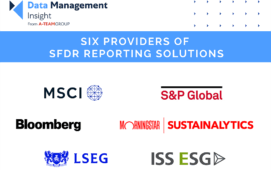
By Stef Nielen, Strategic Business Development, Alveo.
Buy-side financial firms are increasingly looking to tap into alternative data sets, including rapidly emerging environmental, social and governance (ESG) data to give them a competitive edge. There are several drivers behind this.
First, regulation, and the European Sustainable Finance Disclosure Regulation (SFDR) in particular, forces funds to classify whether they are green, semi-green, or not green as a first step and later on requires reporting against a certain number of specific ESG metrics (PAI or Principal Adverse Impact indicators).
The second main driver is the demand to differentiate in the ESG space through new ESG investment offerings. This requires integration of ESG data into the investment process. Other drivers include cost reduction through streamlined optimised data sourcing and user enablement through the timely provisioning of vetted data.
Ultimately, ESG data is capturing information around market externalities that will translate into a company’s Beta as a measure of the volatility, or systematic risk of a security compared to the broader market. The theoretical framework behind this notion is captured in the recent whitepaper ESG Addressing Challenges in ESG Data Management.
Scoping the challenge
Today, buy-side firms are being both pushed and pulled in the direction of ESG data. Yet these organisations have become increasingly aware that the process of integrating and enabling such data in the decision-making processes is challenging.
On the one hand, ESG data is diverse and widely dispersed – even when sourced from the top ESG data providers – and to gather meaningful insight from it, it has to be combined with other data. Paradoxically, this proves that the challenge to empirically resolve a company’s ESG rating cannot rely on just one source but grows harder with the increasing number of disparate sources the organisation uses. On the other hand, many of these firms have come to realise that when a majority of organisations adapt to the same standard vendor ratings, it gets harder to differentiate.
Finding a way forward
To overcome this challenge, many firms have now chosen to augment a vendor’s classification and ratings data with raw ESG data, i.e.: the underlying data retrieved directly from a company’s official reporting or self-declaration. In doing so, however, buy-side firms often struggle to know where to start.
ESG matters are not just limited to discussing the broader objectives of society, but can have a material impact on future cashflows and investments. The need for a structured approach to move into ESG-responsible investing and create the right portfolio is therefore important.
As a first step, firms should make an inventory of what data is out there. While doing so, they should take note that there is a tendency among European asset managers to disregard most vendor scores and instead put more emphasis on the underlying content that drives these scores. In other words, they prefer to use the raw data points and attribute scores themselves.
Next, they should look for a practical solution that can help them manage and organise the data. It is genuinely hard for most buy-side firms to master all their ESG intelligence in a centralised way. It typically requires a lot of in-house data development and does not easily deliver an acceptable return on investment.
Using a data management platform becomes the next step for organisations wishing to extract the best value from disparate data sources. A data management platform can bring these data sources together, normalise them to a common data model and overlay with a standard taxonomy as per the requirement of the portfolio managers for screening investments and the external reporting requirements as per customer or regulatory requirements. As such, across the organisation, all portfolio managers, trading desks and analysts will be able to leverage the data when easily available, properly structured and consistent throughout the firm.
Asset managers are well aware that they will struggle to deliver this capability and manage it in-house given the frequent change in the data and reporting space, and the diversity of ESG data sources. Increasingly, they are looking to go one step further and get a third-party vendor to deliver this data sourcing and integration capability for them.
Typically, this would be delivered by the development of an ESG data master, using the same concept as a security master for financial product terms and conditions. The provider would then implement all the tools around it and be able to scale the master up from different data sources and make sure it links into the existing infrastructure of the asset manager or buy-side firm.
Delivering ROI, scale and analytic capability
It is also key that market data is organised centrally within a system that has strong analytic capabilities, can scale, and governs data lineage appropriately. But above all, it should enable business users to explore diverse data sets across all asset classes via an intuitive user interface and API, while giving access to a data environment that natively runs Python and R. Unfortunately, spreadsheets can’t help here as they don’t scale and become increasingly slow and harder to manage when working with such large datasets and structures.
Once a market data management system as a centralised structure has been put in place, there are a plethora of benefits for an organisation, from data lineage to cost management and allocation, and creating an audit trail. This will significantly increase the return on any existing and future data investments. Firm-wide availability will increase usage and, in turn, will benefit the whole organisation.
Individual desks can access data, manipulate it, and pass it back to the central repository, where it will be mastered, consolidated and become the single version of truth throughout the rest of the organisation. And if everyone within the company uses it, scrutiny around the data and hence the quality will increase. Sharing the same data across the organisation, and contributing by improving the quality and internal assessments will, undoubtedly, increase data ROI.
Subscribe to our newsletter




